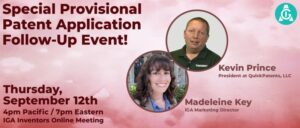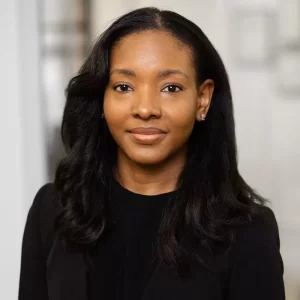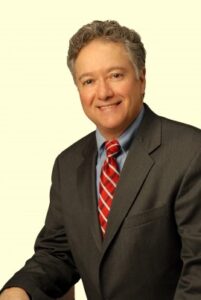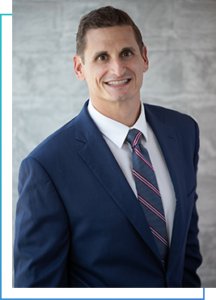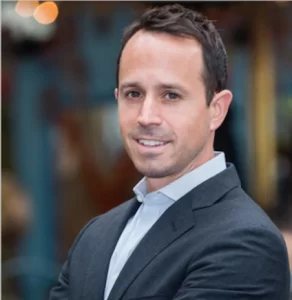Kevin Prince
Ip Lawyers
Quick Patents was founded by Kevin Prince, an inventor and a Registered Patent Agent, to help the independent inventor and small business person protect their inventions. Kevin is an engineer (UC Berkeley, 1988), author of The Art of the Patent, inventor, and co-founder of Inventor’s Forum in 1990, a non-profit inventors assistance group in Orange County, CA. The holder of three patents himself (CD Snaps, Data Glove and Sleeve Saver), Kevin has had multiple successes in business, most notably selling his portable computer accessories business to a public company in 2000. He is also the past president of Grid Art, which manufactured a unique line of art supplies that can “turn anyone into an artist.”
GridArt products have been featured on QVC, and have been sold in at Michael’s, Hobby Lobby, and various catalogs. Kevin enlists the help of multiple former patent examiners (both utility and design), draftsmen, engineers, researchers and administrative assistants, as needed, to get your patent application properly drafted, filed, argued and approved. Kevin answers many common questions about patents during his initial interview with Brian Fried of “Got Invention” radio, as well as in his follow-up interview about design patents.
Kristin Grant
Ip Lawyers
I represent individuals and companies in a broad range of industries, providing counsel on the acquisition, protection, enforcement, and monetization of intellectual property rights.
Prior to forming Grant Attorneys at Law PLLC, I worked as a patent consultant at AltSchool, Inc. – a community of micro-schools using various technologies to streamline the learning and administrative processes. At AltSchool I worked with several software engineering teams through various stages of the patent process. I provided opinions on the patentability of inventions, conducted prior art searches and drafted search reports, drafted and filed patent applications, and responded to office actions.
I gained valuable experience in intellectual property law and licensing while interning with Ladas & Parry LLP and working as an associate at The Law Firm of Spektor & Tsirkin P.C. Between these two intellectual property law firms, I was exposed to a wealth of legal issues in the areas of patent, trademark, trade secret, and copyright law.
Currently, I serve on the Board of Directors of the New York Law School Alumni Association. I am a member of the New York Chapter of Entrepreneurs Organization and I serve on the board of the Entrepreneurs Organization Accelerator.
From Fall 2021 through Spring 2022 I was an adjunct professor teaching the USPTO Trademark Clinic at New York Law School.
David A. Boag
Ip Lawyers
David counsels everyone from publicly listed companies to startups and entrepreneurs on early-stage IP protection, helping them protect their innovations and develop their brands through strategic patent and trademark prosecution. He conducts pre-launch clearance studies to help avoid infringement allegations and conducts corporate IP due diligence to avoid running into infringement traps.
He has experience in fields as diverse as cryptocurrency and NFTs, cannabis and CBD, software, mobile apps, food and beverage, fashion, book publishing, non-profits, and consumer electronics.
David has spoken frequently in the areas of intellectual property issues in the cannabis and cryptocurrency industries. He has been involved with the New York City Bar Association Patents Committee, where he chaired the CLE Subcommittee. He is also active in the small law firm practice development community.
David started his career at a highly regarded NYC IP firm gaining experience in high-stakes patent litigation, international patent enforcement and portfolio management, and trademark prosecution and brand protection. David stayed with that firm through 2013 when he started BLPLLC in a 70-square-foot WeWork space in NYC’s SoHo neighborhood.
Besides being an attorney and small business owner, David has interned in the D.C. bureau of a major newspaper, delivered pizza, and clerked for a state court judge. In his time away from the firm, David can be found hiking in NYS’s Adirondack Mountains—where he’s just shy of the halfway mark in his quest to become a 46er—listening to Metallica and Slayer, cooking, and spending time with his family.
Alan M. Sack
Ip Lawyers
Alan Sack is a Registered Patent Attorney and an experienced intellectual property attorney. A graduate of MIT and the Benjamin N. Cardozo School of Law, Alan helps his clients protect their patents, copyrights, trademarks and trade secrets in disputes before district courts across the United States, the United States Patent and Trademark Office (US PTO), as well as before the United States International Trade Commission (US ITC). He has served as lead and associate counsel in numerous patent, trademark, unfair competition and copyright litigations and has also mediated intellectual property disputes.
In the realm of patent law, Alan handles patent and design patent litigation matters before U.S. district courts, and inter partes matters before the US PTO, including patent appeals, reissues, reexaminations, and post-issue review proceedings. He also counsels clients on patent preparation and infringement matters, and has extensive experience in the preparation, prosecution, and appeals of patent applications before the US PTO in a broad spectrum of technologies and designs. He is experienced in patent and copyright protection of technologies relating to computer sciences and business methods, as well as nanotechnology, biotechnology, medical devices, imaging, LED lighting, mechanical devices, energy storage, radiation detection, superconductors, computer sciences, signal processing, iontophoresis and chemical technologies, waste treatment, polymer molding and processing, chemical engineering, petroleum processing, films, fluid handling, and business methods. Alan also has successfully overseen opposition proceedings before the European and Japanese Patent Offices, and handles licensing negotiations and preparation of license agreements.
Alan is experienced in trademark, unfair competition, and trade secret litigation in the U.S. district courts, and opposition and cancellation proceedings before the US PTO. He routinely counsels clients in adoption and clearance of trademarks and service marks and the protection of trade secrets, as well as U.S. and foreign trademark filing, prosecution, opposition, and appeals. His practice also encompasses counseling and negotiation of branding and advertising transactions. He advises clients regarding protection and use of trademarks in advertising and product packaging, advertising claims, and the use of appropriate marking of patents and registered trademarks on product packaging and brochures. Alan has extensive Trademark, Copyright, Trade Secret & UC protection, Counseling, Licensing, and Litigation experience in the Apparel, Banking, Entertainment, Fabrics, Food, Footwear, Gaming, Music, & Restaurant industries. Alan has been a longtime member of the International Trademark Association (INTA) and an active member of the Trade Name Subcommittee of the Trademark Enforcement Committee of INTA. Alan has also handled a variety of copyright and entertainment related litigation, registration and counseling matters, and has litigated software and television copyright infringement actions in U.S. district courts and before the US ITC.
Derek Fahey, Esquire
Ip Lawyers
I am an engineer and a patent attorney. I truly love what I do. I am a naturally inquisitive person, I love understanding how things work and how I can make them better. I enjoy being involved with the creative process – and I consider myself very fortunate that as a patent attorney I can help people profit from their ideas, concepts and innovations. My clients inspire me, which compels me to help them so that they can improve the lives of others.
I graduated from Florida State University, magna cum laude, with a Bachelor of Science in Industrial Engineering. Before attending law school to study patent law, I worked as an engineer for several years. I use my engineering experiences to help protect my clients’ inventions on a daily basis.
While I was a practicing engineer I gained experience as an Industrial Engineer at Boston Scientific, a medical device company, helping develop coronary stents. I was also fortunate enough to work as a Senior Field Engineer with Schlumberger, a global energy services company. While at Schlumberger I worked in different countries all over the world, including Algeria, Canada, France and the United States. As a Senior Field Engineer with Schlumberger, I worked with and troubleshot sophisticated electronic equipment and software programs in very remote areas, including the Sahara Desert.
After leaving Schlumberger, I worked for NextEra Energy, formally Florida Power and Light. At NextEra Energy, I designed electrical infrastructure and facilities for various locations. My engineering experience helps me understand my clients complex mechanical, electrical and software-related inventions.
Allow me to use my experience as an engineer and training as a patent attorney to help you achieve your goals.
Abraham Cohn
Ip Lawyers
Intellectual Property, Licensing, and Corporate Transactions Transactions
Mr. Cohn negotiates and structures the protection, development, license, and transfer of intellectual property and commercial work. Significant IP and Corporate Transactional work includes:
- Drafting Operating, Partnership, Shareholder Agreements;
- Advising Clients on the enforceability of Non-Compete, NDA, and Non-Solicitation Agreements;
- Conducting screening searches in Trademark Electronic Search System (TESS) and other commercial trademark screening software to determine the viability of prospective trademarks;
- Drafting and prosecuting trademark applications in the USPTO; Activities include the preparation of a multitude of prosecutorial, enforcement, and maintenance documents (Declarations of Use & Application for Renewal under Sections 8 & 9, Declarations of Use & Incontestability under Sections 8 & 15, Intent-To-Use Applications including the subsequent filing of extension requests and Statements of Use, initial Specimen submissions and re-submissions);
- Coordinating with foreign trademark attorneys regarding the filing of USPTO Trademark Applications;
- Drafting Cease and Desist Letters for Trademark Infringement, Trademark Assignment Agreements, Demand letters, Consent Agreements;
- Advising, drafting, and advising on all matters pertaining to GDPR Agreements and Cookie collection policies;
- Advising Clients on unique and idiosyncratic registrability issues concerning Cannabis/Hemp/CBD Trademarks;
Scott M. Sisun, Esq.
Insurance Lawyers
n 2016, Scott was identified as “one to watch” in the World Trademark Review 1000 list of Leading Trademark Professionals. Prior to forming Sisun Law, Scott was an attorney with prominent New York City firms, and a judicial law clerk to now-retired judge John A. O’Shaughnessy. As a Trademark Examining Attorney with the U.S.P.T.O, Scott experienced firsthand the review and prosecution of trademark applications, as well as representation of the U.S.P.T.O. before the T.T.A.B. in ex parte appeals.
Scott works closely with entrepreneurs, start-ups, mid-sized companies and large established entities in various industries to help them successfully reach their business and legal goals.
With more than fifteen years of experience, Scott has successfully handled numerous intellectual property and business law matters. He has prosecuted, managed, enforced and litigated numerous trademark and copyright matters. He has drafted and negotiated a variety of IP and business law agreements and has represented clients before the USPTO, TTAB, federal and state courts.
Scott has consistently been recognized as a Leading Trademark Professional in the World Trademark Review 1000 list of Leading Trademark Professionals.
Scott has served on various intellectual property committees such as the Trademark and Unfair Competition and Fashion Law Committees of the New York City Bar, and the Enforcement Sub Committee of the International Trademark Association (INTA).
Scott also writes and speaks extensively on a wide variety of intellectual property topics, including trademark registration and prosecution, licensing, sports, entertainment, and gTLD matters. He has been a moderator and panelist at numerous intellectual property-related events. He is also co-author of Loss of Trademark Rights a Practice Note published by Practical Law.
He earned a Masters of Law in Intellectual Property from the Benjamin N. Cardozo School of Law. Among his judicial and government positions, Scott began his career in New York as a judicial law clerk to Judge John A. O’Shaughnessy, and was a Trademark Examining Attorney with the United States Patent and Trademark Office in Alexandria, Virgina. Scott’s private sector attorney experience includes the intellectual property group at leading mid-sized law firm Carter Ledyard & Milburn LLP in New York and Special Counsel with the AmLaw 200 international law firm, Kelley Drye & Warren, LLP.
Patrick Stanzione
Ip Lawyers
Patrick Stanzione was born in Yonkers, New York, and grew up in Upstate NY while attending Saint Patrick’s Catholic School. Patrick received a Bachelor of Science degree in Electrical Engineering from the highly recognized Rensselaer Polytechnic Institute (RPI) in 1990, with an emphasis in electronics, semiconductor chip design and manufacturing, and laser optics, before earning a Juris Doctor degree from Western New England School of Law. Patrick is admitted to the Bars of the District of Columbia, New York State, and the United States Patent and Trademark Office (Registration Number 40,434).
During his undergraduate studies, obtaining his Bachelor of Science degree at RPI in Electrical Engineering, Patrick worked for about 5 years at International Business Machines (IBM) in the field of semiconductor chip manufacturing and design. During Patrick’s time at IBM, he obtained extensive experience working in a clean room environment with semiconductor chip fabrication and design, as well as film deposition, vapor deposition, etching, sputtering, electron beam implantation, measuring and testing of chip design specifications, as well as other processes involved in semiconductor chip fabrication and design.
Section 33 (b)(5) Defenses For Common Law Trademark Owners
Understanding Section 33(b)(5) of the Lanham Act is essential for trademark owners navigating the complexities of trademark infringement and defenses. This provision specifically addresses defenses available to common law trademark owners in cases of alleged infringement. This article will explore the implications of Section 33(b)(5), its relevance to common law trademark rights, and how it affects the legal landscape for trademark owners.
Overview of Common Law Trademark Rights
Common law trademark rights arise automatically when a business begins using a mark in commerce. Unlike federally registered trademarks, which require a formal application process through the United States Patent and Trademark Office (USPTO), common law rights are established simply through actual use of the mark in a specific geographic area. This means that the first entity to use a mark in commerce gains exclusive rights to that mark within that area, even if it is not registered.
Limitations of Common Law Rights
While common law trademarks provide some level of protection, they come with limitations. The rights are generally confined to the geographic area where the mark is used, meaning that businesses may not have recourse against infringers operating outside their local market. Additionally, without federal registration, common law trademark owners lack certain legal presumptions that can simplify enforcement actions.
Understanding Section 33(b)(5)
Section 33(b)(5) of the Lanham Act provides a specific defense for common law trademark owners facing infringement claims. This section states that a defendant may avoid liability for trademark infringement if they can demonstrate that:
- The mark in question was not registered at the time of the alleged infringement.
- The defendant was using the mark in good faith and without knowledge of the plaintiff’s prior use.
This provision serves as a safeguard for defendants who may be unaware of existing trademarks when they begin using a similar mark.
Implications for Common Law Trademark Owners
Good Faith Defense
The good faith defense under Section 33(b)(5) is particularly significant for common law trademark owners. If a defendant can prove they were using a similar mark without knowledge of the plaintiff’s prior use, they may escape liability even if there is some likelihood of confusion among consumers. This aspect emphasizes the importance of due diligence before adopting new marks.
Burden of Proof
While Section 33(b)(5) provides a potential defense for defendants, it also places a burden on common law trademark owners to establish their prior use and demonstrate that their mark has acquired distinctiveness. To succeed in an infringement claim, they must show that their mark is valid and protectable under common law standards.
Challenges Faced by Common Law Trademark Owners
Proving Prior Use
One of the most significant challenges for common law trademark owners is proving prior use. Unlike federally registered trademarks, which provide clear documentation of ownership and usage dates, common law rights rely heavily on evidence such as sales receipts, advertisements, and other records demonstrating consistent use of the mark in commerce.
Geographic Limitations
Common law rights are inherently limited by geography. If a common law trademark owner operates primarily in one region, they may struggle to enforce their rights against infringers in other areas where they do not have established usage. This limitation can lead to complications when competing businesses expand into new markets.
Lack of National Protection
Without federal registration, common law trademark owners lack national protection against similar marks. This means that another entity could register a similar mark federally and gain broader rights, potentially hindering the original owner’s ability to enforce their common law rights.
Strategies for Protecting Common Law Trademark Rights
To navigate these challenges effectively, common law trademark owners should consider several strategies:
- Documentation: Maintain thorough records of all instances where the mark is used in commerce. This includes advertising materials, sales invoices, and any other evidence that can substantiate claims of prior use.
- Monitoring: Regularly monitor the marketplace for potential infringements or similar marks being used by competitors. Early detection can help mitigate potential conflicts before they escalate into legal disputes.
- Cease-and-Desist Letters: If an infringement is identified, sending a cease-and-desist letter can serve as an initial step toward resolving the issue without resorting to litigation. This letter should assert your rights and demand that the infringing party cease their use of the mark.
- Consider Federal Registration: While common law rights provide some protection, pursuing federal registration can significantly enhance your legal standing and simplify enforcement actions against infringers.
- Legal Counsel: Engaging with an attorney who specializes in intellectual property can provide valuable guidance on protecting your trademark rights and navigating potential disputes effectively.
Conclusion
Section 33(b)(5) serves as an important consideration for common law trademark owners facing infringement claims. While it provides a potential defense for defendants who can demonstrate good faith use without knowledge of prior marks, it also underscores the challenges faced by common law owners in proving their rights and establishing distinctiveness.Navigating the complexities of trademark protection requires diligence and proactive measures from business owners. By understanding their rights under Section 33(b)(5) and implementing effective strategies for protecting their trademarks, common law owners can better position themselves to defend against infringement while ensuring their brand identity remains intact in an increasingly competitive marketplace.


